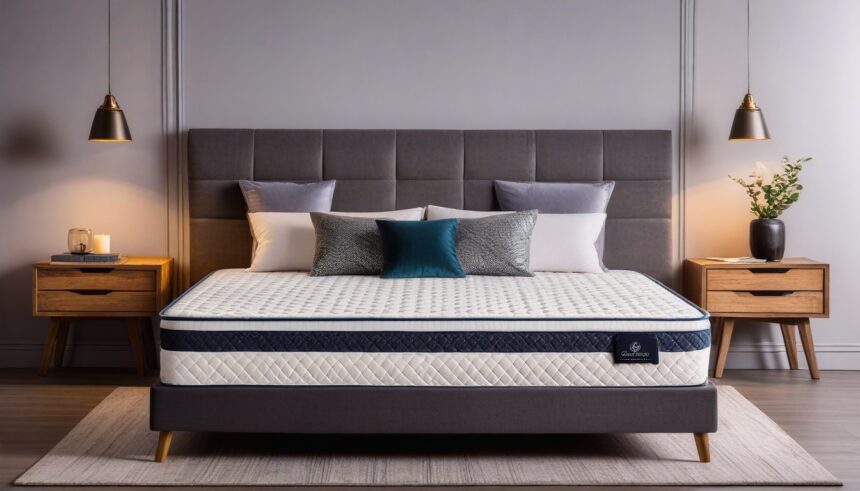For many, the quest for a perfect night’s sleep feels like a mythical journey. We toss and turn, battle restless partners, and wake up feeling like we’ve wrestled a bear. Enter the memory foam mattress BED, a modern sleep hero promising blissful slumber. But before you dive headfirst into this luxurious cloud, a crucial question arises: how much does a good memory foam mattress cost?
Fear not, weary sleepers! This blog post is your roadmap to navigating the world of memory foam mattresses and understanding the price tag attached to a good night’s rest. We’ll delve into the factors that influence cost, explore the used market, and compare prices to traditional mattresses. Buckle up, because we’re about to decode the price puzzle and help you find the perfect mattress for your budget and your dreams.
First things first: What is a Memory Foam Mattress?
Imagine a mattress that molds to your every curve, cradling you like a gentle hug. That’s the magic of memory foam. This special material, developed by NASA, is made of polyurethane infused with carbon dioxide. It reacts to your body heat and pressure, conforming to your shape and providing pressure relief. This means no more waking up with aches and pains from sleeping on a lumpy, unforgiving surface.
But memory foam isn’t just about comfort. It also boasts a range of benefits:
- Motion isolation: No more midnight mattress tremors! Memory foam absorbs movement, so a restless partner won’t disturb your sleep.
- Spinal alignment: The conforming nature of memory foam helps keep your spine in a neutral position, promoting good posture and reducing back pain.
- Hypoallergenic: Dust mites and allergens are no match for memory foam’s tightly woven surface, making it ideal for allergy sufferers.
- Durability: Memory foam mattresses are built to last, with some boasting a lifespan of 10 years or more.
So, how much does this sleep nirvana cost?
Well, dear reader, the answer isn’t as simple as a price tag on a shelf. The price of a memory foam mattress can vary widely, depending on several factors:
- Brand: Luxury brands like Tempur-Pedic and Serta will command a premium price, while less-known brands may offer similar quality at a lower cost.
- Size: Queen-size mattresses are typically the most popular and affordable, while king-size and California King sizes will cost more due to their increased material usage.
- Thickness: Thicker mattresses generally use more memory foam and will be more expensive. A standard thickness is around 10-12 inches, but some luxury models can reach 14 inches or more.
- Density: Higher-density memory foam offers better support and durability, but it also comes at a higher price.
- Features: Additional features like cooling gel layers, adjustable firmness, and built-in massage motors can significantly increase the cost.
The Price Spectrum: From Budget-Friendly to Dreamland Deluxe
To give you a clearer picture, let’s break down the price range of memory foam mattresses:
- Budget-Friendly (Under $500): Yes, you can find decent memory foam mattresses at this price point. However, be prepared for thinner mattresses, lower densities, and possibly fewer features. These are ideal for guest rooms or budget-conscious sleepers.
- Mid-Range ($500-$1,500): This sweet spot offers a good balance of quality and affordability. You’ll find thicker mattresses, higher densities, and some additional features like cooling gel layers. Perfect for everyday sleepers who prioritize comfort and value.
- Luxury ($1,500+): Here’s where you’ll find the crème de la crème of memory foam mattresses. Expect top-of-the-line materials, advanced features like adjustable firmness, and unparalleled comfort. These are for the true sleep connoisseurs who want the ultimate night’s rest.
Second-Hand Snoozing: Exploring the Used Market
If you’re on a tight budget or looking for an eco-friendly option, consider the used market. You can find decent deals on lightly used memory foam mattresses, sometimes at a fraction of the original price. However, be cautious:
- Inspect carefully: Look for signs of wear and tear, sagging, or mold.
- Test it out: If possible, try lying on the mattress before you buy it to see if it feels comfortable and supportive.
- Ask questions: Find out why the seller is getting rid of the mattress and make sure it’s not due to any hidden issues.
Memory Foam vs. Traditional Mattresses: A Cost Comparison
The Battle of the Beds: Where do Memory Foam Mattresses Stand?
Now that we’ve explored the world of memory foam mattresses and its cost variations, let’s see how it fares against the classic innerspring mattresses that have graced bedrooms for generations. Buckle up, sleep warriors, because we’re about to enter the arena of mattress price comparisons!
Innerspring: The Established Contender
Innerspring mattresses have been around for ages, and their popularity endures for a reason. Their basic construction of coils and padding offers a familiar bounce and supportiveness, often at a lower price point than memory foam. Here’s a breakdown of their cost range:
- Budget-Friendly (Under $300): You can find basic innerspring mattresses at this price, perfect for kids’ rooms or occasional guests. However, expect less contouring and potentially shorter lifespans.
- Mid-Range ($300-$1,000): This range offers better quality coils, improved padding, and more features like additional comfort layers. Perfect for everyday sleepers who want value for their money.
- Luxury ($1,000+): High-end innerspring mattresses boast individually wrapped coils for superior motion isolation and plush comfort layers. However, they might not match the contouring and pressure relief of high-end memory foam.
Memory Foam: The Comfort Challenger
Memory foam, with its luxurious hug and pressure-relieving magic, might carry a higher price tag compared to innerspring. However, its unique benefits and potential for longevity can justify the additional cost:
- Memory foam excels in pressure relief and conforming support, crucial for side sleepers and those with back pain. Innerspring mattresses might offer good overall support, but they sometimes lack the contouring needed for pressure relief.
- Motion isolation is a memory foam superpower, meaning your restless partner won’t disturb your slumber like they might on a traditional mattress. Innerspring mattresses, while improved, can still transfer movement.
- Memory foam boasts a longer lifespan compared to innerspring, with some high-quality models lasting up to 10 years or more. While good innerspring mattresses can last a long time too, memory foam might offer an edge in durability.
The Verdict: Price vs. Sleep Quality
So, which mattress reigns supreme? Ultimately, the choice between memory foam and innerspring boils down to your priorities and budget. If pure affordability is your main concern, a good innerspring mattress might be the answer. But if you prioritize superior pressure relief, motion isolation, and potential long-term value, investing in a high-quality memory foam mattress could be the sleep upgrade you’ve been dreaming of.
Remember, the perfect mattress is a personal journey. Consider your sleep preferences, budget, and any specific needs you might have. Take advantage of trial periods offered by many brands to test out different mattresses before committing. And always prioritize your sleep – after all, a good night’s rest is priceless!
Bonus Tip: Don’t be afraid to negotiate! Especially when purchasing from independent retailers, negotiating a bit on the price might just land you the perfect mattress at a slightly sweeter deal.
I hope this comprehensive guide has helped you navigate the world of memory foam mattresses and understand where they stand in the price game. Now go forth and conquer your quest for a perfect night’s sleep!







